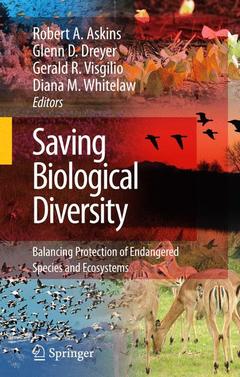Saving Biological Diversity, Softcover reprint of hardcover 1st ed. 2008 Balancing Protection of Endangered Species and Ecosystems
Coordonnateurs : Askins Robert A., Dreyer Glenn D., Visgilio Gerald R., Whitelaw Diana M.

Robert Askins is Professor of Biology at Connecticut College, where he teaches courses in ecology, environmental studies, animal behavior, and ornithology. His research focuses on the ecology and conservation of migratory birds in both their northern breeding areas and tropical wintering areas. He has analyzed the habitat requirements of forest birds that nest in deciduous forests in New England and Japan, and the ecology of songbirds that spend the winter in the U.S. Virgin Islands. He also has studied species that are restricted to early successional forest habitats. He has published scientific papers in numerous journals including Science, Proceedings of the National Academy of Sciences, Wetlands, Ecology, Current Ornithology, Studies in Avian Biology, Wilson Bulletin, and Conservation Biology. In 2000 he published "Restoring North America’s Birds; Lessons from Landscape Ecology," a book on the ecology and conservation of North American birds. Currently he is chair of the Biology Department at Connecticut College and Karla Heurich Harrison Director of the Goodwin-Niering Center for Conservation Biology and Environmental Studies.
Glenn D. Dreyer is the Charles & Sarah P. Becker ‘27 Director of the Connecticut College Arboretum and an Adjunct Associate Professor of Botany at Connecticut College. His career has focused primarily on the interface between horticulture and ecology from both academic and management perspectives. The Connecticut College Arboretum has historically operated as both public garden featuring native plants and as an ecological field site for research and teaching. Dreyer’s research has focused mainly on the ecology and control of invasives, vegetation management, and documenting big and historic trees. He also serves as Executive Director of the Goodwin-Niering Center.
Gerald R. Visgilio is Professor of Economics at Connecticut College, where he has spent nearly three decadesworking in the ar
Date de parution : 10-2010
Ouvrage de 228 p.
15.5x23.5 cm
Date de parution : 09-2008
Ouvrage de 228 p.
15.6x23.5 cm



